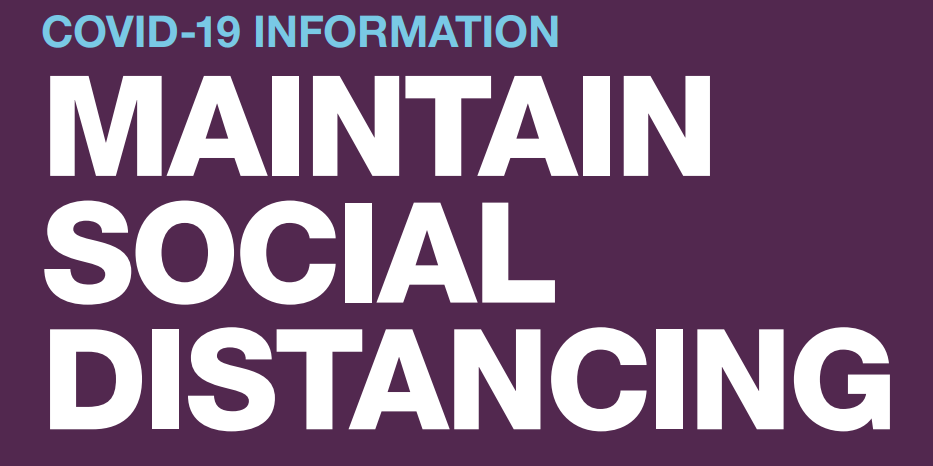The COVID-19 (coronavirus) pandemic has created uncertain times for just about everyone, including business owners. People are getting a lot of information from a lot of different places, but social distancing is one recommendation that just about everybody seems to agree on to help slow the spread of the virus.
The goal is to slow the spread of the disease, “flattening the curve” to give healthcare organizations a better chance of providing care to all the people who need it.
10 tactics to adapt your business for social distancing
Whether you’re a small services business like an accounting or consulting firm, a high-traffic business like a retail store, or even a restaurant or coffee shop, here are 10 actions that you can consider to help keep you, your customers, and the community at large safer.
Let’s dig into the most important tactics you can use to practice social distancing in your business.
1. Inform customers and employees about social distancing
First, arm your customers and employees with more information. The CDC offers a number of printable fact sheets you can display at your place of business, informing people about the need for social distancing and how diseases like COVID-19 are transmitted.
2. Avoid direct physical contact (e.g., handshakes)
Physical contact is the fastest and most common way for viruses to spread. Do what you can to limit physical contact between people at your location. Do not shake hands. Do not hug. Find another way to greet people that involves no direct contact.
3. Postpone large-scale events or stream them
As recommended by the CDC, it’s in the best interest of public health to cancel or postpone large-scale in-person events like conferences. Gatherings of more than 10 people are not recommended.
Musicians, churches, and other participatory businesses might consider streaming their concerts and their services online. Look to YouTube Live or ViewStub, a live event streaming platform, as a way to broadcast yourself.
4. Replace in-person conversations with virtual ones
Instead of meeting face to face, meet virtually. In most cases, it’s not too difficult to replace a simple meeting with a video conference or a conference call.
Pick a platform that will suit your meeting needs. If it’s a small committee meeting, Google Hangouts will fit the bill. If you need to host a webinar or large meeting, try Microsoft Teams Live Events or GoToWebinar. And if you want to hold a virtual conference, check out ViewStub.
5. Allow remote work
Even better, transition to a remote work setup. If any of your employees can do their jobs from home, let them work from home. Facebook, Google, Twitter, and Amazon (and GoDaddy) are just some of the companies enacting more flexible work-from-home policies in the wake of the coronavirus outbreak.
For some roles, remote work even leads to an increase in productivity — so don’t worry right now about productivity loss.
The need for many businesses to operate as dispersed teams also presents an opportunity to go paperless. You don’t have to go into the office for a form or report if you can access it remotely.
Find an offsite server host to manage your company’s information and enterprise software, and you can have people working everywhere at any time. And if you have proprietary information, or people’s personal information like their finances and health information, there are regulatory-compliant server companies that can help you. They follow all the latest health and financial privacy regulations, so your information will be well-protected.
If possible, have your remote employees use a virtual private network (VPN) to log into the company servers. This helps to prevent hackers from trying to intercept the traffic between your employees’ computers and your servers.
6. Enable flexible scheduling
For employees who must be physically present, consider staggering your work schedules. This way, you can have a smaller number of employees present at your location at any given time.
7. Create additional physical space in brick-and-mortar locations
If you have a business that serves people physically (like a restaurant that serves food to customers), increase distance between those customers. For example, you could widen shopping aisles or create more distance between tables.
8. Lean on online services when possible
If possible, transition to online-only or remote service options. For example, Starbucks recently transitioned to a “to-go only” model to reduce foot traffic.
A lot of restaurants around the country are shifting to a pick-up only model, not allowing anyone to dine in. Retail stores, including some liquor stores and grocery stores, are adopting a similar model.
Then you can either ship them or walk them out to their car when they drive up. (Shipt.com is a delivery option for groceries and other large retailers.)
For example, in an effort to help restaurants, Uber Eats committed to “Supporting the restaurant industry through an uncertain season” by waiving the delivery fee “for the more than 100,000 independent restaurants across US & Canada on Uber Eats.”
9. Reduce cash handling
As a temporary measure for brick-and-mortar locations, reduce or eliminate cash handling. Instead, use tap-based payment systems or digital payment systems whenever possible.
Consider PayPal, Venmo, Cash, or even Apple Pay and Google Pay as a way to avoid handling money. Even ACH payments are becoming more accepted with some businesses.
10. Stagger customer flow
You can also incorporate social distancing by staggering customer flow in some way. For example, you may choose to serve customers only one at a time, or you may funnel them through a different mode of service, like through a drive-through window. Read about how some grocery stores are staggering shopping hours to help protect elderly shoppers.
Conclusion
Even if you aren’t a member of an at-risk population segment, your participation in social distancing can — and will — save lives. You may not be able to follow all of these strategies, but the more active and aware you are, the better.



